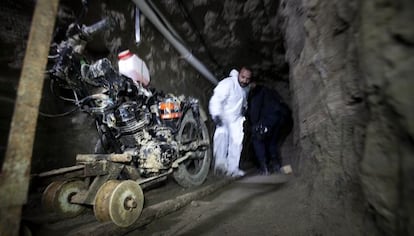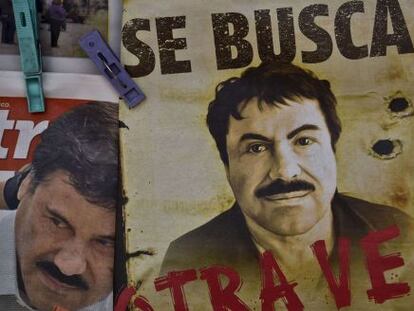Five security breaches (or mistakes) that helped ‘El Chapo’ escape
Tunnel diggers worked in the open while a DEA warning was reportedly ignored


Joaquín El Chapo Guzmán Loera is, for now, a free man. While Mexican President Enrique Peña’s government is still reeling from the devastating blow it received when the notorious Sinaloa cartel leader made his daring escape on July 18, authorities have no doubt that the former convict had inside help.
The 58-year-old drug kingpin escaped from El Altiplano maximum security prison through a 1,500-meter tunnel dug underneath the complex. At least seven prison officials have been arrested and more than 40 others have been put under investigation.
At least seven prison officials have been arrested and more than 40 others are under investigation
Since the drug kingpin’s arrest in February 2014, there have been at least five security lapses – or even worse, blunders – at the penitentiary, which eventually allowed the world’s most-wanted and richest trafficker to mock his captors by fleeing from his tiny cell through a shower stall.
1. The privilege of being locked up alone. In the past, Mexican prison authorities would constantly move the most dangerous inmates to other sections of a prison, or even to other facilities. That was the approach taken recently with Miguel Treviño Morales, the notorious Zeta leader known as Z-40. But in El Chapo’s case, he had been kept in the same prison and had more than 500 visitors since his arrest, including relatives, lawyers, lovers and, without a doubt, the accomplices who helped him escape.
2. Access to the tunnel. Using passageways to smuggle drugs or help its leaders escape from prison are two of the Sinaloa cartel’s well-known traits. More than 100 tunnels that lead to the United States have been discovered in the border states of Chihuahua, Sonora and Baja California, all of which have helped the cartel transport shipments to the north while bypassing Mexican and US law enforcement. Known as “the man of the tunnels,” El Chapo has used them on several occasions to flee his safe houses when authorities have tried to close in. In May 2014, the cartel helped three of El Chapo’s associates escape from a prison in Culiacán, Sinaloa state though a tunnel that had the same characteristics used by Guzmán at El Altiplano. It took six months before authorities fired the military jailers, according to the Mexico City daily La Jornada.
3. In broad daylight. El Chapo’s accomplices worked in the open and no one asked any questions. For about $94,000, they bought a tract of land some 1,500 meters away from El Altiplano and near a military base, and constructed a building measuring about 200 square meters. Some local residents were employed in the initial phase but when it was time to dig the tunnel, they were let go. Some 3,250 tons of dirt and rubble were removed with the help of a motorized vehicle installed inside the long burrow. The military, local police or municipal officials never took any notice. The worst part is that the building lacked the necessary construction permits.
4. DEA advisory. Since his arrest in February 2014, while he was visiting his family at an apartment in the Pacific resort city of Mazatlán, El Chapo had been anxious for his cohorts to rescue him. According to the Associated Press, the US Drug Enforcement Administration (DEA) alerted the Mexican government of Guzmán’s planned escape. Peña Nieto administration officials have denied the report but the DEA has not. In any case, El Chapo’s track record speaks for itself. In 2001, Guzmán fled the Puente Grande prison in Jalisco state by hiding in a laundry cart.
5. Lack of internal controls. Before his escape from Puente Grande, El Chapo lived a charmed life during the eight years he was in prison – women, parties and other comforts were all on hand. It was when he found out that his extradition to the United States was imminent that he made plans for his escape by paying off 62 prison officials, including the warden. With his past record, it was obvious that the Sinaloa drug chief would be willing to bribe authorities at El Altiplano. But no special security measures or controls were introduced to prevent what has become the most spectacular prison escape of the century.
Tu suscripción se está usando en otro dispositivo
¿Quieres añadir otro usuario a tu suscripción?
Si continúas leyendo en este dispositivo, no se podrá leer en el otro.
FlechaTu suscripción se está usando en otro dispositivo y solo puedes acceder a EL PAÍS desde un dispositivo a la vez.
Si quieres compartir tu cuenta, cambia tu suscripción a la modalidad Premium, así podrás añadir otro usuario. Cada uno accederá con su propia cuenta de email, lo que os permitirá personalizar vuestra experiencia en EL PAÍS.
¿Tienes una suscripción de empresa? Accede aquí para contratar más cuentas.
En el caso de no saber quién está usando tu cuenta, te recomendamos cambiar tu contraseña aquí.
Si decides continuar compartiendo tu cuenta, este mensaje se mostrará en tu dispositivo y en el de la otra persona que está usando tu cuenta de forma indefinida, afectando a tu experiencia de lectura. Puedes consultar aquí los términos y condiciones de la suscripción digital.
More information
Archived In
Últimas noticias
From Andorra to Gibraltar, a black market for Ozempic exploits its success: ‘They’re the most sought-after products in the world’
From Hungary’s Orbán to Chile’s Kast: How Trump helps turbo charge the far right
Magnets in their heads: How some animals guide themselves using the Earth’s magnetic field
The brief rise and retreat of Generation Z in Mexico
Most viewed
- Why we lost the habit of sleeping in two segments and how that changed our sense of time
- Trump’s obsession with putting his name on everything is unprecedented in the United States
- Charles Dubouloz, mountaineering star, retires at 36 with a farewell tour inspired by Walter Bonatti
- The Florida Keys tourist paradise is besieged by immigration agents: ‘We’ve never seen anything like this’
- Living in a motorhome due to soaring housing prices in Madrid: ‘I got used to it quickly, but I don’t idealize it’









































